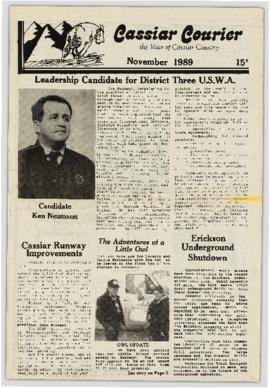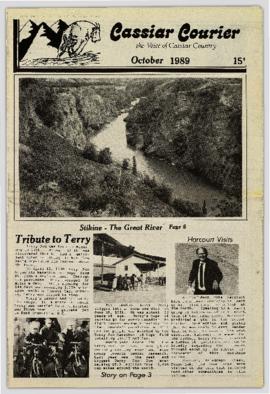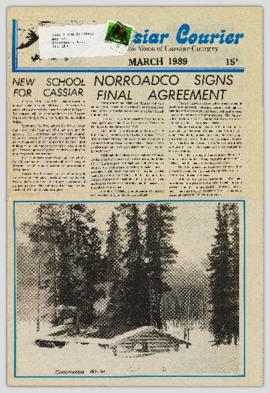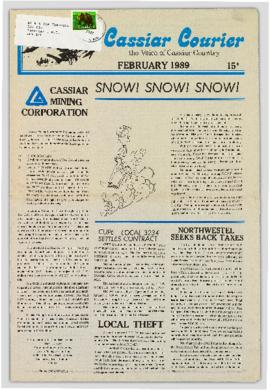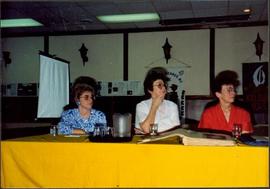File consists of a videocassette (VHS) recording of Mary & Lazare John's 60th Anniversary Party.
Videocassette Summary
Context: Celebratory events for Mary and Lazare John’s 60th Wedding Anniversary, 1989.
Introduction: Party held in an auditorium. Head table in front of a curtained stage, decorated with a blue tablecloth. Streamers and pink, white and blue balloons provide a backdrop for the head table. Silver paper bells decorate the front of the table with a larger “60” sign on the front centre of the tablecloth. There is a large wedding cake situated between Lazare and Mary on the centre of the head table. Pink and white balloons and streamers decorate the walls of the hall.
The party begins with a prayer – the focus is on the head table. Guests seated at long tables are passing along the food, eating and talking. The camera pans in and out to the head table and surveys guests.
Mary and Lazare’s daughter, Winnie, stands behind the head table and addresses the guests. She tells a joke about her parents and then goes to sit down.
An unidentified man approaches the head table and pours drinks for those seated there.
Edward John approaches the head table and shakes both Lazare’s and Mary’s hands. He then talks with them and other guests at the head table for quite awhile.
Young people approach the head table and take photographs of the anniversary couple.
An elderly woman speaks briefly to Mary and Lazare from behind the table. Another woman in a wheelchair speaks to Mary and other guests at the head table.
Edward John (EJ) – EJ introduces himself as the MC and speaks at back of head table to the guests. He asks for round of applause for Lazare and Mary for being able to live with each other or 60yrs. The day they were married, they had no wedding cake, so the cake on the table is to make up for that. 60 years ago, Lazare never said “I do” at the ceremony and Mary is still waiting. He introduces their 9 children from their marriage included the 2 that died: Helen, who was active in Stoney Creek affairs, tribal council and Indian Homemakers Assoc. of BC and Charles (don’t know too much about him). He then introduces the children still remaining: Winnie, Bernice, Florence, Ernie, Gordon, Johnnie and Ray. The anniversary couple have 32 grandchildren, and 25 great-granchildren: many children, grandchildren, great grandchildren. Before asking couple to cut their cake, he introduces speakers. First up is Aileen Kimble (AK) from Vanderhoof.
AK: Friends with the couple for many years, happy anniversary Lazare and Mary.
EJ: No set agenda for this event, just time to celebrate and spend time with the couple. There are 30 people from Sechelt (nieces and nephews) that came up for this event: Valerie and Ken, Randy and Lani, Audrey, Willard, Janice, Bradley and Leonora, Wayne, Rena and Earl, Clarke. (applause) EJ calls on Bridget Moran (BM) to speak.
BM: Told a story about Mary’s wedding day, and when she first came to Stoney Creek. She touches a bit upon Stoney Creek Woman.
David: Tells a story about trapping with Grandfather Lazare. He thanks everyone for coming.
Winnie: Thanks siblings and Dorothy MacIntyre for helping her decorate the “leaning tower of Stoney Creek”. Also thanks Adela and Nicholas George for decorating the wishing well.
EJ: Mary’s cousin from Prince Rupert George and Emily Bird recently celebrated their 50th (?) wedding anniversary. Long time friend is Selina John (SJ), elder to tribal council called to speak.
SJ: She is so happy to be sitting next to sister-in-law. Ever since they both married they worked together. Raising their children together, they were like one big family. Not one cross word between them in 60 years. They’ve been through a lot but one thing stands out – during the day they took care of family and if they had time they would hunt squirrel in the bush. One time they were hunting squirrel and they got lost and it took them forever to find their way home. They came home hungry, frozen and tired and met with husbands who were furious because they thought they had been chasing boys. She talks to young people about the example Mary and Lazare’s marriage should be to the whole community- 60 years they’ve been together. The young generation of today, each walks in their own direction. If you want to have a good life you have to work at it. Marriage is a contract. If you marry you have to work towards it. She’s very proud of her sister-in-law, many times SJ was down especially after her husband died and MJ pulls her up. She wishes Mary and Lazare many more anniversaries to come.
EJ: Calls Sophie Thomas (ST) to say a few words.
ST: Wishes the couple a happy 60th anniversary and many more. She worked together with Mary for the people on reserve. Since they started the fought for running water, now they have sewer.
EJ: Calls Veronica to say a few words.
Veronica: She very happy to be there- to see Mary on her 60th wedding anniversary. It isn’t easy. Mary has faith in the Lord. She didn’t forget her mother’s and grandmother’s words. You have to listen when an elder talks to you. People come to elders for advice and direction and spiritual words too. So it is nice to see Mary and Lazare reach their 60 years of marriage – this is a very holy thing. Holy matrimony is important to keep. She hopes the young generation will take an example from Mary. It is not good to divorce. Always pray. She thanks many people for coming. May the Good Lord look after you wherever you are.
EJ: There are a few more speakers, elders mostly. Mary Pius (MP) from Heightly (?)
MP: Her Aunty Mary and Uncle Lazare have done so much for the people of Stoney Creek. Mary was one of last midwives. She took the baby into world and would help nurse along the young mothers too. Now you have nurses, doctors, hospitals, but we still have to work just as hard to keep the young mothers going. The young generation is still here because of the hard work of Mary and Lazare. We thank them for all the hard work to keep the young ones going. They take care of those who are sick, and help supply Indian medicine. She hopes the good Lord will reward her aunt and uncle and wishes them the best from the Holy Spirit. She wishes good luck to her Aunty Mary and Uncle Lazare.
EJ: There are a couple more speakers, then cutting of the cake, then a 60th anniversary waltz and some entertainment. EJ calls Justa Monk (JM), who has worked with Mary at tribal level carrying on business through the whole tribal area, and who has been deputy chief, past tribal council president and chairman.
JM: In the short time he has known the couple, he has learned many things in his culture and about society today. He is honoured to be there sharing their food. He talks about Lazare’s speaking in church. What they have done in Stoney Creek has spread to other reserves like his. He wishes them well.
EJ: When the couple married 60 years ago, they didn’t have any money. They borrowed $25 from his brother. Lazare went to work and Mary worked too. Lazare worked at a railway tie camp. EJ calls on Evelyn Louie (EL) to speak.
EL: She’s really happy for the couple. She thanks them very much for everything.
EJ: Introduces Ellen Lasert from Burns Lake
EL: She is an apprentice under Mary John. Mary has been an inspiration to her and she brings greetings from people in Burns Lake and Chief (?) Charlie.
[Winnie speaks to Edward John]
EJ: Calls on Cecile Patrick to speak.
CP: She wishes her uncle and auntie a happy anniversary from their family. Thanks everyone for the food and effort in preparing food. She is the second eldest daughter of Lazare’s sister.
EJ: Comments: Lazare and Mary’s doors in Stoney Creek are always open. Every time you visit you are always treated with respect and made to feel at home. He has these wonderful memories of this couple. She always has her smokehouse and her wood fire going all the time. She always has tea ready. He asks Lazare and Mary to cut the cake for the 60th wedding anniversary.
[Lazare and Mary pose with a knife ready to cut the cake. Guests rise to take photographs. Then Mary rises again and tries to remove the cake topper and cut the cake for her guests but it doesn’t cut easily. They are finally told there is already cake for the guests in the kitchen.]
EJ: Calls on Bob Holmes (on piano?) and Jen Hoffner (on accordion) to come to the front.
The recording breaks and screen goes black for a second
Picture resumes and Lazare and Mary are seen doing the anniversary waltz. They dance for a bit and then sit down, but another gentleman takes Mary up front again to continue dancing (a son?).
EJ: Announces the entertainment: the young dancers from Stoney Creek and the PG dancers. He calls dancers to the floor; while waiting he tells a story about a blind snake and a blind rabbit.
Drummers gather and begin to play and sing. Stoney Creek dancers (children of all ages) come to the centre of the dance floor to perform. Second dance is called the “Beaver Dance”. The third dance is called the “ -inaudible- Dance”. The fourth dance is called the “Four Winds Dance”.
Tape ends.
